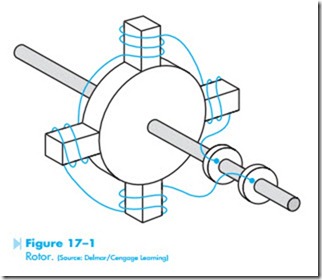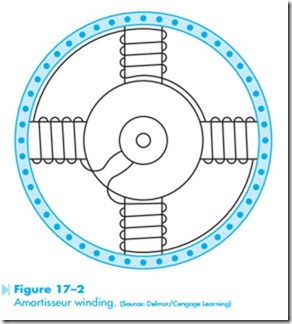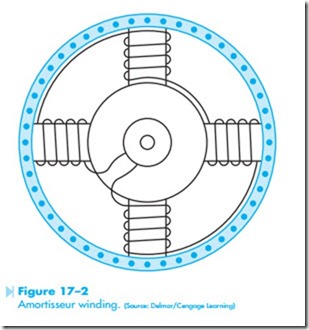The Synchronous Motor
The third type of three-phase motor to be discussed is the synchronous motor. This motor has several characteristics that no other type of motor has. Some of the characteristics of a synchronous motor are:
1. The synchronous motor is not an induction motor. This means that it does not depend on induced voltage from the stator to produce a magnetic field in the rotor.
2. The synchronous motor will run at a constant speed from no load to full load.
3. The synchronous motor has the ability to not only correct its own power factor, but can also correct the power factor of other motors connected to the same line.
The synchronous motor has the same type of stator windings as the other two three-phase motors. The rotor of a synchronous motor has
windings similar to the wound rotor induction motor, Figure 17–1. Notice that the winding in the rotor of a synchronous motor is different, however. The winding of a synchronous motor is one con- tinuous set of coils instead of three different sets as is the case with the wound rotor motor. Notice also that the synchronous motor has only two slip rings on its shaft as opposed to three on the shaft of a wound rotor motor.
STARTING A SYNCHRONOUS MOTOR
The rotor of a synchronous motor also contains a set of type “A” squirrel-cage bars. This set of squirrel-cage bars is used to start the motor and is known as the amortisseur winding, Figure 17–2. When power is first connected to the stator, the rotating magnetic field cuts through the type “A” squirrel-cage bars. The cutting action of the field induces a current into the squirrel-cage bars. The current flow through the amortisseur winding produces a rotor magnetic field that is attracted to the rotating magnetic field of the stator. This causes the rotor to begin turning in the direction of rotation of the stator field. When the rotor has accelerated to a speed that is close to the synchronous speed of the field, DC is connected to the rotor through the slip rings on the rotor shaft, Figure 17–3. When DC is applied to the rotor, the windings on the rotor become electromagnets. The electromagnetic field of the rotor locks in step with the rotating magnetic field of the stator. The rotor will now turn at the same speed as the rotating magnetic field. When the rotor begins to turn at the synchronous speed of the field, there is no more cutting action between the field and the amortisseur winding. This causes the current flow in the amortisseur winding to cease.
Notice that the synchronous motor starts as a squirrel-cage induction motor. Because the rotor bars used are type “A,” they have a relatively high resistance, which gives the motor good starting torque and low starting current. A synchronous motor must never be started with DC connected to the rotor. If DC is applied to the rotor, the field poles of the rotor become electromagnets. When the stator is energized, the rotating magnetic field begins turning at synchronous speed. The electromagnets of the rotor are attracted to the rotating magnetic field of the stator and are alternately attracted and repelled 60 times a second. As a result, the rotor does not turn.



